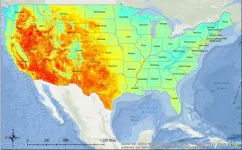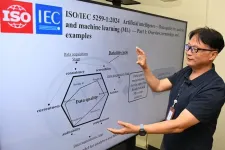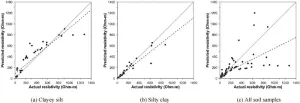(Press-News.org) Researchers have for the first time identified degeneration-associated “molecular markers” – observable changes in cells and their gene-regulating networks – that are shared by several forms of dementia that affect different regions of the brain. Critically, the UCLA-led research, published in the journal Cell, also identified markers specific to different forms of dementia, and the combined findings represent a potential paradigm shift in the search for causes, treatments and cures.
“This work provides new insight into the mechanisms of neurodegeneration and identifies new candidate pathways for development of therapeutics,” said senior and corresponding author Daniel Geschwind, MD, PhD, a professor of human genetics, neurology and psychiatry at the David Geffen School of Medicine at UCLA and director of the Institute for Precision Health at UCLA Health.
Previous studies have focused on a single disorder at a time. Called case-control studies, they compared “diseased” cells with normal ones and often just focused on one brain region. But in this research, the scientists also looked at molecular changes across three different forms of dementia that can involve “tau pathology,” the accumulation of abnormal tau protein in vulnerable regions that differ across disorders.
They performed single-cell genomic analysis on more than 1 million cells to identify distinct and shared molecular markers in three related conditions: Alzheimer’s disease, frontotemporal dementia (FTD) and progressive supranuclear palsy (PSP). In addition to validating changes previously observed in AD, they identify dozens of cell types whose changes are shared across multiple dementias and several cell types whose changes in disease were specific to a single disorder, many of which had not been previously identified.
“Different conditions have different patterns of degeneration. We reasoned that comparison across cases from different disorders, in addition to the typical case-control comparison, would be useful to identify shared components of neurodegeneration and to understand cell type-specific changes that underlie all these conditions,” Geschwind said, adding that most studies profile only one brain region – typically the frontal lobe.
“In dementia and neurodegenerative disease more generally, specific brain regions and cells are most vulnerable in each disease. This is what leads to the different symptoms and signs across disorders,” Geschwind said. “Since regional vulnerability is a core feature of the disorders, we reasoned that studying more than one region would give new insights, and that was the case. In addition to identifying shared and distinct molecular markers, we showed how genetic risk relates to these disease-specific pathways that are altered in the brain.” Using this study design, the investigators found four genes that marked vulnerable neurons across all three disorders, highlighting pathways that could be used to develop new therapeutic approaches.
First author Jessica Rexach, MD, PhD, an assistant professor in neurology and neurobehavioral genetics at the David Geffen School of Medicine at UCLA, said this work “profoundly shifted” her perspective on the mechanisms underlying disease susceptibility.
“It is remarkable and humbling to have identified several distinct molecular differences that set apart cells from individuals with one form of dementia from those with closely related diseases. Although these disease-specific differences were among the minority of the changes observed in diseased brains, they were strongly linked to heritability. This surprising finding opens new avenues for understanding why and how certain genes influence the risk of developing one brain disease over another closely related condition.”
Combined, Alzheimer’s, FTD and PSP affect more than 28 million people worldwide. Although Alzheimer’s has been studied extensively, there is no cure, and existing, approved medications only slow disease progression. There are few clinical trials available for FTD and PSP.
“We have created an extensive data resource that paves the way for identifying and exploring new therapeutic candidates for neurodegenerative dementias,” Rexach said. “We have pinpointed specific molecules that can now be advanced as potential novel regulators of disease in experimental systems – importantly, grounded in primary human disease data. Additionally, we’ve uncovered unexpected conceptual phenomena that may explain why certain cells exhibit more resilience or vulnerability to disease, and we’re eager to investigate these findings further.”
The researchers:
Identified unique changes specific to Alzheimer’s disease and demonstrated that several findings in Alzheimer’s were also observed across the other disorders, identifying targets for therapeutic development.
Found that “cellular resilience programs” – molecular mechanisms that support cells in response to injury – activated or failed differently, when comparing the same cell types across disorders.
Were surprised to discover that each of the three disorders had changes in cells of the primary visual cortex – the area of the brain that processes visual information and which was thought to be unaffected by dementia. In PSP, this discovery revealed previously unknown changes in brain cells called astrocytes.
Identified specific changes in the expression of certain tau-related genes and others in PSP. These appear to correlate with the unique pattern of brain cell degeneration that is observed in PSP.
The authors, who will next begin experiments to validate the causal nature of their findings, anticipate the study will inspire similar cross-disorder research.
“These data show that known risk genes act in specific neuronal and glial states or cell types that differ across related disorders. Moreover, causally associated disease states may be limited to specific cell types and regions,” the Cell article concludes. “This underscores the importance of examining multiple brain regions to understand causal disease pathways at the cellular level, which we show provides a clearer picture of shared and disease-specific aspects of resilience and vulnerability to inform the therapeutic roadmap.”
Authors The full list of authors is published with the Cell article.
Funding Funding for this work was provided by Roche Pharmaceuticals (D.H.G., D.M.), BrightFocus (D.H.G., J.E.R), Rainwater Charitable Foundation (D.H.G. and W.W.S), NIH grants (K08 NS105916 (J.E.R), R01 AG075802 (J.E.R., L.T.G), 5UG3NS104095 (D.H.G)), and John Douglas French Alzheimer’s Foundation (J.E.R.). The UCSF Neurodegenerative Disease Brain Bank is supported by NIH grants AG023501 and AG019724, the Rainwater Charitable Foundation, and the Bluefield Project to Cure bvFTD. The University of Pennsylvania Center for Neurodegenerative Disease Research is supported by NIH grant P01AG066597, P30AG072979 and U19AG062418.
Disclosures Geschwind has received research funding from Hoffman-LaRoche for this project. A full declaration of interests is published with the article.
(D.H.G. has received research funding from Hoffman-LaRoche for this project. D.C. is a full-time employee of F. Hoffmann-La Roche, Basel, Switzerland. During the study period, D.M. was a full-time employee of F. Hoffmann-La Roche, Basel, Switzerland, and is currently a full-time employee of Biogen, Cambridge, MA, USA.)
Article Cell: Cross-disorder and disease-specific pathways in dementia revealed by single cell genomics.
DOI 10.1016/j.cell.2024.08.019
END
Researchers uncover shared cellular mechanisms across three major dementias
Work may open pathways to new therapeutic targets
2024-09-11
ELSE PRESS RELEASES FROM THIS DATE:
The Neanderthals may have become extinct because of their isolated lifestyle
2024-09-11
Neanderthal remains recently discovered in a cave in France support well-known theory of why the Neanderthals became extinct, researchers behind a new study say.
In recent years, researchers have offered different explanations for why modern humans survived and the Neanderthals became extinct some 40,000 years ago.
A new study from the Globe Institute at the University of Copenhagen supports one of the main hypotheses. The researchers behind the new study discovered Neanderthal remains of a male in a cave in southern France, ...
Microorganisms can travel long distances in the troposphere
2024-09-11
Analysis of air samples taken at altitudes of up to 3,000 metres above Japan has revealed the presence of a vast range of viable bacteria and fungi transported by air masses originating more than 2,000 kilometres away, in regions enriched with fertilisers and pesticides. The study, published in Proceedings of the National Academy of Sciences (PNAS), reveals a new way in which human, animal and plant pathogens may travel to distant geographical regions. This research has been led by the Barcelona Institute for Global Health (ISGlobal), a centre supported by “la Caixa” Foundation, in collaboration with the Daniel ...
Ropirio launches from Wyss Institute to develop first-in-class lymphatic medicines
2024-09-11
The Wyss Institute at Harvard University announced today that Ropirio Therapeutics, Inc. (Ropirio) has secured a worldwide, exclusive license from Harvard’s Office of Technology Development (OTD) and Boston University (BU)’s Technology Development office for novel molecules that activate the lymphatic system - a first in the pharma industry.
“There has been a tremendous amount of research into the lymphatic system over the last decade, with scientists uncovering new lymphatic vasculature and understanding the critical role it plays across a wide range of serious diseases. Ropirio is building on this explosion of research ...
Oxycodone use in Australia dropped 45% after policy changes to opioid prescribing
2024-09-11
Between 2018 and 2020, Australia implemented policy changes to improve the quality and safety of opioid prescribing, with a specific focus on oxycodone. A new study led by The University of Queensland (UQ) using wastewater analysis has determined that oxycodone consumption in Australia dropped by 45% from 2019 to 2020, coinciding with those national policy changes.
In November 2019, the Australian National Prescribing Service launched a federal initiative to improve opioid prescribing. The initiative involved alerting high-prescribing clinicians that their opioid prescribing practices were outside typical ...
Hot streets, historic bias: effects on neighborhood walking in older adults
2024-09-11
A neighborhood’s walkability is affected by many factors such as street connectivity and density; access to destinations and aesthetics; investment in walking and biking infrastructure; and the presence or absence of urban natural features, specifically tree cover.
Not all neighborhoods are alike. Many neighborhoods in impoverished and minority communities lack the cooling effect of vegetation and tree cover, especially in urbanized areas. As a result, residents face the “heat island effect,” where temperatures remain higher in urban areas ...
ETRI establishes international standards for AI safety and reliability support
2024-09-11
Recently, many major countries around the world, starting with the U.S., Japan, Germany, China, U.K., etc., have issued an administrative order to ensure the safety of AI technology, putting an emphasis on the safe, effective implementation of AI into their systems. In line with such trends, Korean researchers have collaborated with renowned AI experts from all around the world to create new AI-related international standards, garnering attention from the global AI community.
Proposal No.
Title
Status
ISO/IEC ...
Atypical metabolite levels at birth may increase SIDS risk
2024-09-11
WHAT:
Newborns who had an atypical pattern of metabolites were more than 14 times as likely to die of sudden infant death syndrome (SIDS), compared to infants who had more typical metabolic patterns, according to a study funded in part by the National Institutes of Health. Metabolites are molecules produced by the body’s various chemical reactions. Researchers found that infants who died of SIDS had a specific pattern of metabolites compared to infants who lived to their first year. The researchers believe that checking for this pattern could provide ...
How toxic are they? Researchers investigate the environmental consequences of new biotechnological pesticides
2024-09-11
Biotechnological pesticides are a promising alternative to traditional chemical pesticides. But we have limited knowledge of how toxic they are to other organisms in the environment beyond regulatory assessments. A new research centre will now work to provide this knowledge – especially to ensure the EU has a chance of joining the growing market for biotechnological pesticides. As for now, Europe has failed to keep up.
"If a thing kills something, we need to know how it kills, and who and what else it may kill," says Professor Nina Cedergreen of the University of Copenhagen’s Department of Plant and Environmental Sciences.
She is ...
Advancing power grounding systems: A novel predictive model for soil resistivity
2024-09-11
Proper power grounding systems are necessary for maintaining the safety and reliability of critical electrical subsystem infrastructure, such as substations. Power grounding systems provide a low-resistance path for electrical fault currents to flow into the earth, preventing electrical shocks, fires, and damage to vital equipment. Investigation of soil resistivity is crucial for designing power grounding systems. For the most cost-effective and efficient grounding systems for electrical substations, it is imperative to carefully ...
Unique nanodisk pushing photonic research forward
2024-09-11
Researchers at Chalmers University of Technology, in Sweden, have for the first time succeeded in combining two major research fields in photonics by creating a nanoobject with unique optical qualities. Since the object is a thousand times thinner than the human hair, yet very powerful, the breakthrough has great potential in the development of efficient and compact nonlinear optical devices. “My feeling is that this discovery has a great potential,” says Professor Timur Shegai, who led the study at Chalmers.
Photonic applications harness the power of light-matter interactions to generate ...
LAST 30 PRESS RELEASES:
Injectable breast ‘implant’ offers alternative to traditional surgeries
Neuroscientists devise formulas to measure multilingualism
New prostate cancer trial seeks to reduce toxicity without sacrificing efficacy
Geometry shapes life
A CRISPR screen reveals many previously unrecognized genes required for brain development and a new neurodevelopmental disorder
Hot flush treatment has anti-breast cancer activity, study finds
Securing AI systems against growing cybersecurity threats
Longest observation of an active solar region
Why nail-biting, procrastination and other self-sabotaging behaviors are rooted in survival instincts
Regional variations in mechanical properties of porcine leptomeninges
Artificial empathy in therapy and healthcare: advancements in interpersonal interaction technologies
Why some brains switch gears more efficiently than others
UVA’s Jundong Li wins ICDM’S 2025 Tao Li Award for data mining, machine learning
UVA’s low-power, high-performance computer power player Mircea Stan earns National Academy of Inventors fellowship
Not playing by the rules: USU researcher explores filamentous algae dynamics in rivers
Do our body clocks influence our risk of dementia?
Anthropologists offer new evidence of bipedalism in long-debated fossil discovery
Safer receipt paper from wood
Dosage-sensitive genes suggest no whole-genome duplications in ancestral angiosperm
First ancient human herpesvirus genomes document their deep history with humans
Why Some Bacteria Survive Antibiotics and How to Stop Them - New study reveals that bacteria can survive antibiotic treatment through two fundamentally different “shutdown modes”
UCLA study links scar healing to dangerous placenta condition
CHANGE-seq-BE finds off-target changes in the genome from base editors
The Journal of Nuclear Medicine Ahead-of-Print Tip Sheet: January 2, 2026
Delayed or absent first dose of measles, mumps, and rubella vaccination
Trends in US preterm birth rates by household income and race and ethnicity
Study identifies potential biomarker linked to progression and brain inflammation in multiple sclerosis
Many mothers in Norway do not show up for postnatal check-ups
Researchers want to find out why quick clay is so unstable
Superradiant spins show teamwork at the quantum scale
[Press-News.org] Researchers uncover shared cellular mechanisms across three major dementiasWork may open pathways to new therapeutic targets



